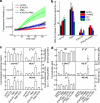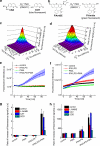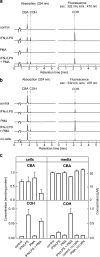Global profiling of reactive oxygen and nitrogen species in biological systems: high-throughput real-time analyses
- PMID: 22139901
- PMCID: PMC3270955
- DOI: 10.1074/jbc.M111.309062
Global profiling of reactive oxygen and nitrogen species in biological systems: high-throughput real-time analyses
Abstract
Herein we describe a high-throughput fluorescence and HPLC-based methodology for global profiling of reactive oxygen and nitrogen species (ROS/RNS) in biological systems. The combined use of HPLC and fluorescence detection is key to successful implementation and validation of this methodology. Included here are methods to specifically detect and quantitate the products formed from interaction between the ROS/RNS species and the fluorogenic probes, as follows: superoxide using hydroethidine, peroxynitrite using boronate-based probes, nitric oxide-derived nitrosating species with 4,5-diaminofluorescein, and hydrogen peroxide and other oxidants using 10-acetyl-3,7-dihydroxyphenoxazine (Amplex® Red) with and without horseradish peroxidase, respectively. In this study, we demonstrate real-time monitoring of ROS/RNS in activated macrophages using high-throughput fluorescence and HPLC methods. This global profiling approach, simultaneous detection of multiple ROS/RNS products of fluorescent probes, developed in this study will be useful in unraveling the complex role of ROS/RNS in redox regulation, cell signaling, and cellular oxidative processes and in high-throughput screening of anti-inflammatory antioxidants.
Figures








Similar articles
-
Detection and Characterization of Reactive Oxygen and Nitrogen Species in Biological Systems by Monitoring Species-Specific Products.Antioxid Redox Signal. 2018 May 20;28(15):1416-1432. doi: 10.1089/ars.2017.7398. Epub 2017 Nov 17. Antioxid Redox Signal. 2018. PMID: 29037049 Free PMC article. Review.
-
Toward selective detection of reactive oxygen and nitrogen species with the use of fluorogenic probes--Limitations, progress, and perspectives.Pharmacol Rep. 2015 Aug;67(4):756-64. doi: 10.1016/j.pharep.2015.03.016. Epub 2015 Apr 11. Pharmacol Rep. 2015. PMID: 26321278 Free PMC article. Review.
-
Detection of mitochondria-generated reactive oxygen species in cells using multiple probes and methods: Potentials, pitfalls, and the future.J Biol Chem. 2018 Jun 29;293(26):10363-10380. doi: 10.1074/jbc.RA118.003044. Epub 2018 May 8. J Biol Chem. 2018. PMID: 29739855 Free PMC article.
-
The role of glutathione and glutathione peroxidase in regulating cellular level of reactive oxygen and nitrogen species.Microvasc Res. 2020 Sep;131:104010. doi: 10.1016/j.mvr.2020.104010. Epub 2020 Apr 23. Microvasc Res. 2020. PMID: 32335268
-
Reaction-Based Fluorescent Probes for the Detection and Imaging of Reactive Oxygen, Nitrogen, and Sulfur Species.Acc Chem Res. 2019 Sep 17;52(9):2582-2597. doi: 10.1021/acs.accounts.9b00302. Epub 2019 Aug 28. Acc Chem Res. 2019. PMID: 31460742 Free PMC article. Review.
Cited by
-
Carcinoma origin dictates differential skewing of monocyte function.Oncoimmunology. 2012 Sep 1;1(6):798-809. doi: 10.4161/onci.20427. Oncoimmunology. 2012. PMID: 23162747 Free PMC article.
-
Alterations in bioenergetic function induced by Parkinson's disease mimetic compounds: lack of correlation with superoxide generation.J Neurochem. 2012 Sep;122(5):941-51. doi: 10.1111/j.1471-4159.2012.07836.x. Epub 2012 Jul 11. J Neurochem. 2012. PMID: 22708893 Free PMC article.
-
Detection and Characterization of Reactive Oxygen and Nitrogen Species in Biological Systems by Monitoring Species-Specific Products.Antioxid Redox Signal. 2018 May 20;28(15):1416-1432. doi: 10.1089/ars.2017.7398. Epub 2017 Nov 17. Antioxid Redox Signal. 2018. PMID: 29037049 Free PMC article. Review.
-
Demystifying the management of cancer through smart nano-biomedicine via regulation of reactive oxygen species.Naunyn Schmiedebergs Arch Pharmacol. 2025 Jan;398(1):497-532. doi: 10.1007/s00210-024-03469-x. Epub 2024 Oct 31. Naunyn Schmiedebergs Arch Pharmacol. 2025. PMID: 39480523 Review.
-
Reactive oxygen species mediate bioeffects of static magnetic field via impairment of long-chain fatty acid degradation in Escherichia coli.Front Microbiol. 2025 Jun 25;16:1586233. doi: 10.3389/fmicb.2025.1586233. eCollection 2025. Front Microbiol. 2025. PMID: 40636487 Free PMC article.
References
-
- Fruehauf J. P., Meyskens F. L., Jr. (2007) Reactive oxygen species: a breath of life or death? Clin. Cancer Res. 13, 789–794 - PubMed
-
- D'Autréaux B., Toledano M. B. (2007) ROS as signaling molecules: mechanisms that generate specificity in ROS homeostasis. Nat. Rev. Mol. Cell Biol. 8, 813–824 - PubMed
-
- Veal E. A., Day A. M., Morgan B. A. (2007) Hydrogen peroxide sensing and signaling. Mol. Cell 26, 1–14 - PubMed
-
- Rhee S. G. (2006) Cell signaling. H2O2, a necessary evil for cell signaling. Science 312, 1882–1883 - PubMed
Publication types
MeSH terms
Substances
Grants and funding
LinkOut - more resources
Full Text Sources
Other Literature Sources

